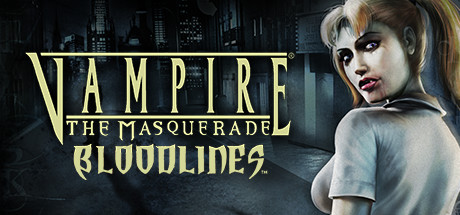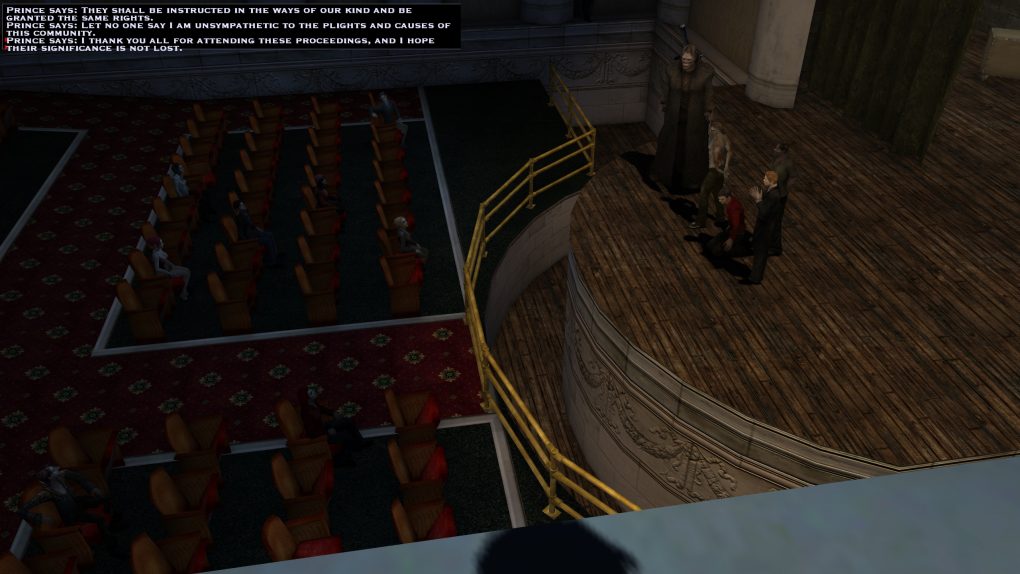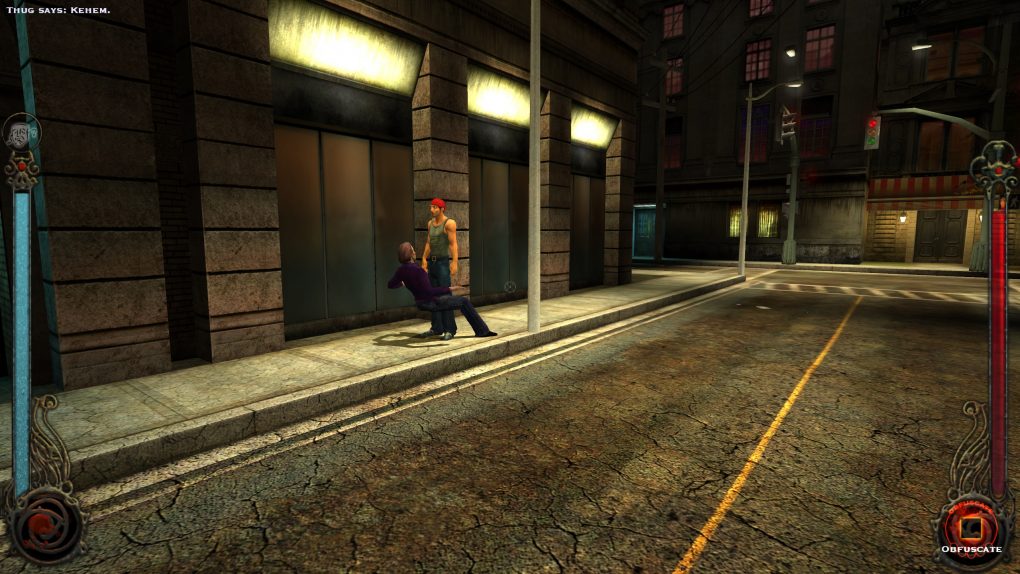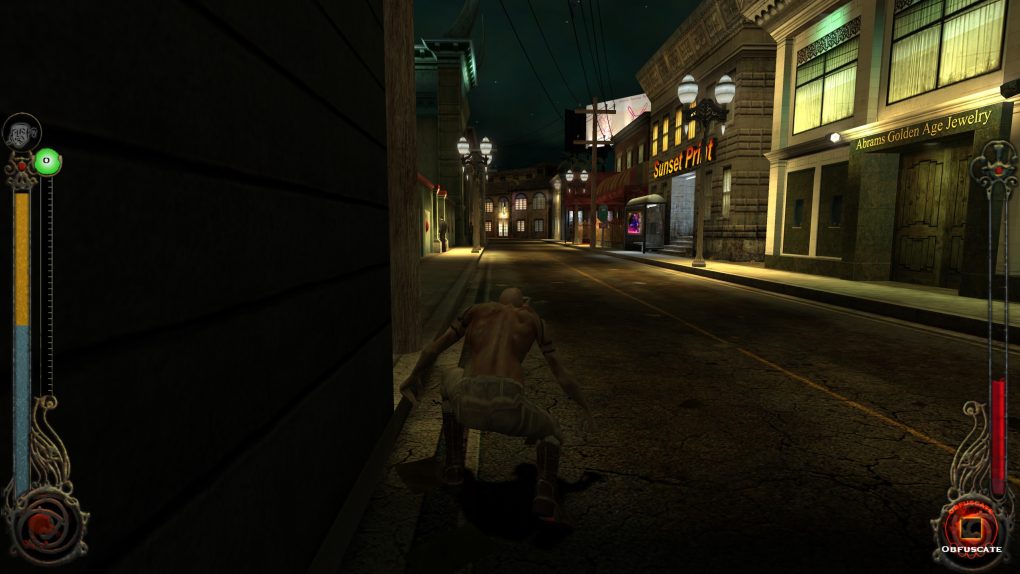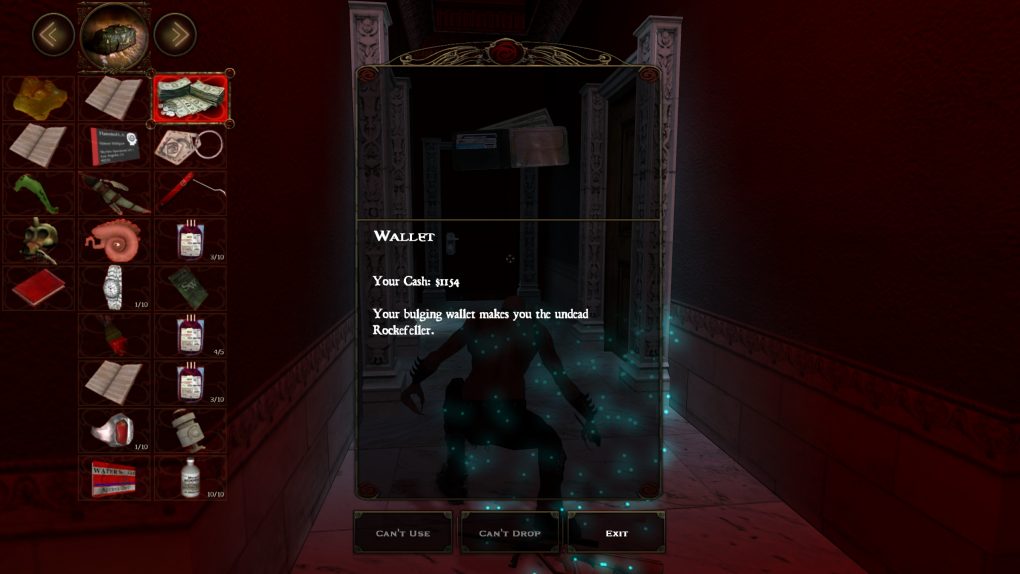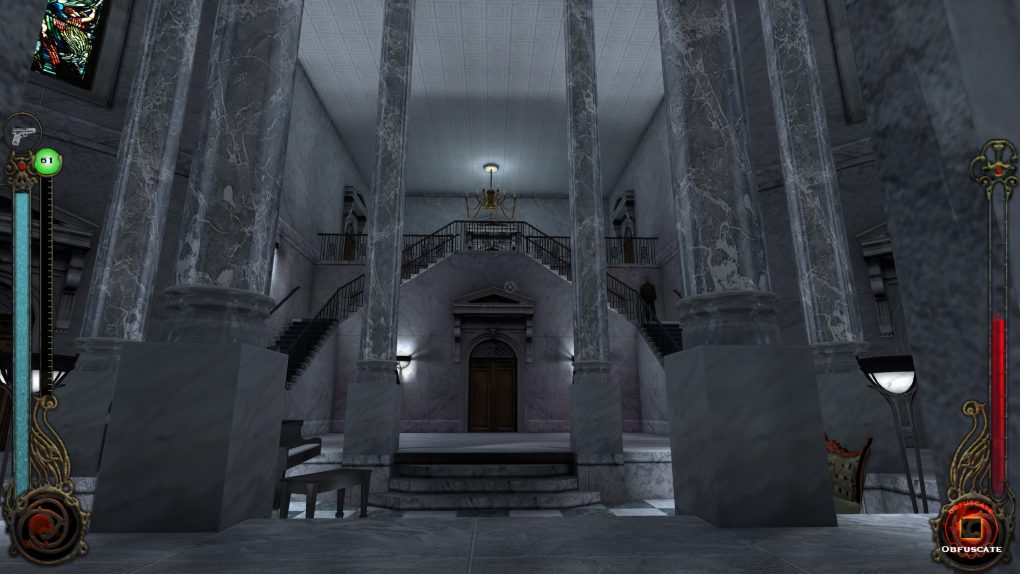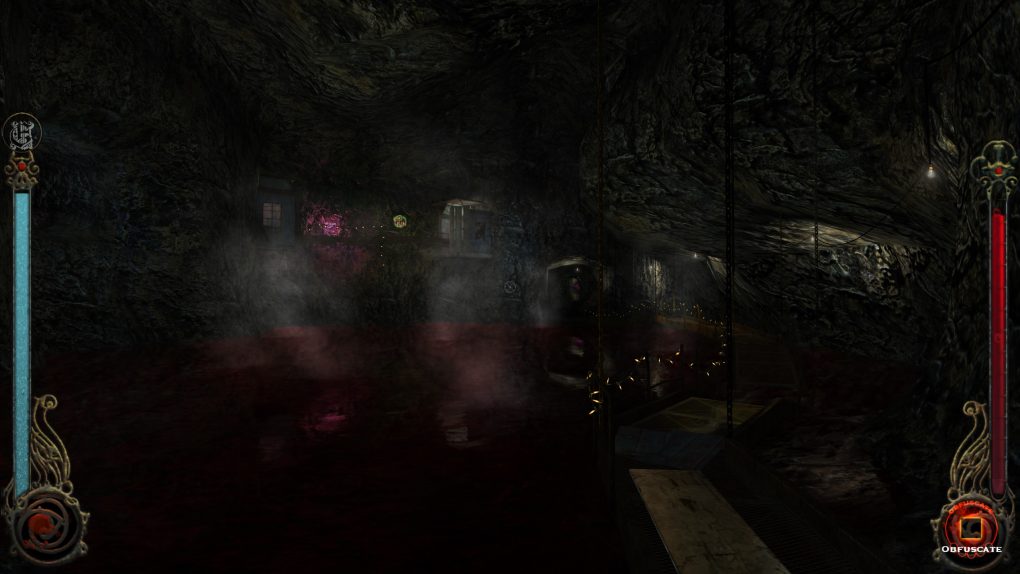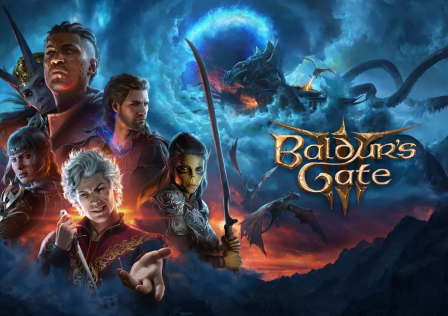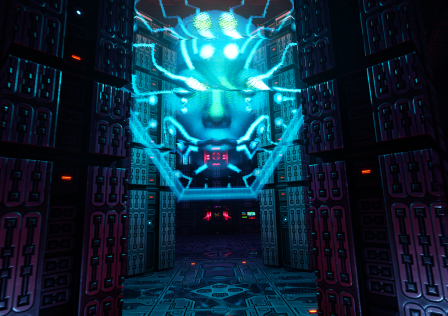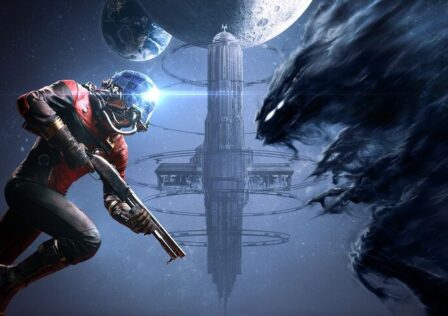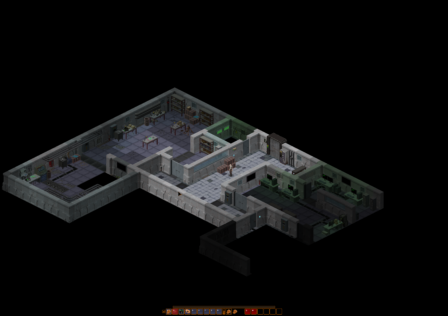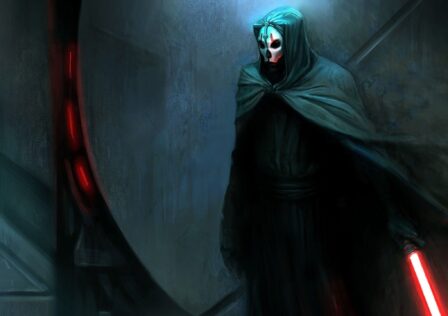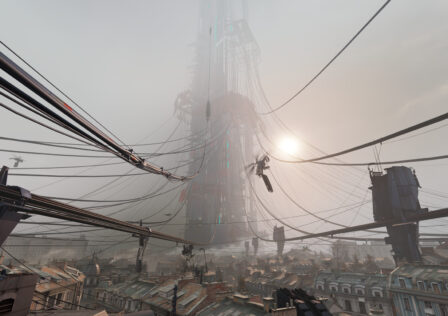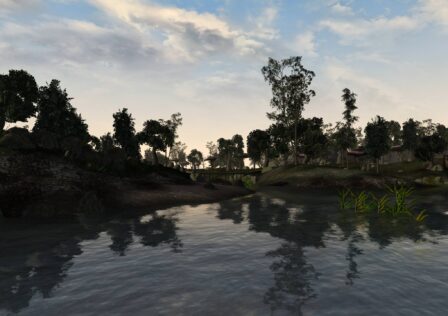Vampire: The Masquerade – Bloodlines was the final game by Troika Games. It is a legendary PC exclusive RPG released in 2004, and the first ever Source game. It is based on the tabletop RPG called Vampire: The Masquerade.
Bloodlines is a first person and third person action RPG known for its quality… but more than one meaning is associated with the word “quality” in this case. On the one hand, it is known as one of the best, most thorough video game RPGs ever made with some of the best writing quality in video game history. On the other hand, it is known for being blatantly incomplete and incredibly buggy, perhaps even unplayable without mods.
As such, we will be analyzing and reviewing the game with the unofficial patch applied to it, as it’s truly required to play the game to completion. After all, the version sold by GOG comes with this patch already. Vampire: The Masquerade – Bloodlines is a somewhat forgotten great that needs to be reevaluated.
The Story
Vampire: The Masquerade – Bloodlines is available on Steam, and also DRM free on GOG. The GOG version comes with an unofficial patch preinstalled as we mentioned, and is 100% playable from the get go unlike the Steam version which requires the unofficial patch to be installed. Although the GOG version’s unofficial patch is out of date, so it is suggested to install the latest one even over a GOG copy.
This franchise takes place in a modern day California (Los Angeles). As the name implies, a code called the Masquerade is in place, in order to conceal and protect supernatural, undead species. This setting is like the real world for all intents in purposes, save for a secret supernatural society that masquerades alongside us.
After you create your character, the game starts with a scene showing (off screen) your character becoming embraced by a Kindred. In other words, being turned into a vampire. Unknown assailiants then barge into the room and stick the two of you with wooden stakes. No, you don’t die, but you are incapacitated. Right after this we all get a taste of what is to come; political turmoil, your character (often called Fledgling) caught in the middle of it.
Your Sire (vampire who embraced you) is executed, and your execution is ordered by the Prince as well. But the de facto leader of a group called the Anarchs, Nines Rodriguez, stands up for you, and as a result of all the commotion stemming from this, you are spared. The game then takes off with a dialogue heavy tutorial mission that is very well designed, and while it is a blatant tutorial, it makes sense. Your abilities are new to you, and the events during this mission add to the plot and world as a new faction and character are introduced.
After this tutorial, you are on your own, sent to the first of four hubs in the game—Santa Monica. RPG players will feel at home here. The hub design is loosely inspired by Deus Ex, a game which Bloodlines references a few times, but the games it most resembles are the first two Fallout games. Troika was founded by Fallout developers after all, and that really shows in both this and Arcanum. The satire here is so similar to the Fallouts.
The levels in Bloodlines are non-linear hubs and have a decent amount of exploration and side quests, though fewer secrets than the likes of Deus Ex. Quest content varies per hub; Hollywood and Santa Monica have the most, Downtown has noticeably less than those two, and Chinatown has by far the least because the last quarter of the game roughly was clearly rushed (Chinatown is the last hub unlocked). When using the latest Unofficial Patch however, the last act of the game from Chinatown to the end has been fleshed out substantially more now, to the point where it barely feels rushed.
It is not completely open world or free roam because hubs are unlocked sequentially according to main quest progression. Santa Monica is first, Downtown second, Hollywood third, Chinatown fourth. It is best to go out of your way to pick up side quests, as they are all outstanding in Bloodlines. Each hub has a uniquely designed sewer system, which Nosferatu players will use primarily for travel (although it is not technically required).
As you make your way through the game, it becomes painfully obvious (but in a good way) that you are nothing more than a pawn in something bigger. For the majority of the game you are used by the Camarilla (organized vampire group with the most power) prince LaCroix, the legendary Anarch figure Smiling Jack, Anarch supporter and Baron of Hollywood Isaac Abrams (who is a sharp contrast from the actual Anarchs), Nosferatu primogen Gary, and later on the local Kuei-jin leader Ming Xiao. Every one of these factions has an explorable HQ if you want to call it that. It is never clear who, if anyone, can be trusted, nor is it made clear what their true intents are. Even the first character you meet, Smiling Jack, keeps throwing “What-ifs” at you if you choose to speak to him in Downtown LA, gauging your thoughts and reactions but leaving it at that. Planting ideas in your head, trying to sow dissention in the ranks of the Camarilla through you.
Every character you converse with, significant to the plot or no, is a unique character. The writers obviously made it a point to flesh out everyone so that they have more than the bare minimum required for their role. An insignificant character will be unique in their own way, and everyone has distinct facial animations and mannerisms and voice acting to set them apart. So much additional effort that so few games have. Only Planescape: Torment is similarly excellent in this regard; that is, only these two games have this level of character development for all characters, out of all large scale non-linear games.
Every character and every quest, including side quests, adds to the whole. They all serve as world building and thematic exposition. These characters and quests are often different thematically; some rooted in philosophy, some serve to introduce new classic horror elements to the story and put a twist on them to make them unique, others social commentary and often satirical, others making fun of stereotypes. So multifaceted that you never know what to expect, such that it takes you by surprise emotionally, only adding to its potency and effectiveness. But they all fit, they all create different emotion, and they are all powerful and showcase a high level of writing talent that is very rare in gaming.
Furthermore, Bloodlines serves as an excellent period piece, examining 1990s / early 2000s Los Angeles and the culture at the time. Especially the Gothic subculture and LA nightlife of course; the scenery, the design of clubs throughout the game, the music, the presence of things like snuff films and strange fetishes and kinky late night talk shows and cheating characters, all of this combined with the specific classic horror elements found throughout Bloodlines from the famous Ocean House Hotel representing the classic haunted house horror, to the “You Only Die Once a Night” quest representing George A. Romero classic zombies in the graveyard horror (a la Night of the Living Dead, and the character who gives this quest is even named Romero), it all serves to create a perfect period piece. Everything in Bloodlines works together to bolster the atmosphere, a real professional design that is so rarely seen in video games.
This is most unlike your mediocre run-of-the-mill BioWare RPGs and countless others, where many quests (side quests especially) are just busywork and do not carry any thematic weight or greater purpose because the writing is too shallow in these games. No, every single quest has greater purpose in Bloodlines, everything is story driven and it makes every quest unique. As far as RPGs go, this seems to be exclusive to the elite few, all being created by either Interplay/Black Isle Studios, Troika, or Obsidian.
Bloodlines does a phenomenal job in casting the player in several directions, throwing you off and playing with your expectations. It does this in a pleasantly original way. I personally played this game for the first time in 2016 after having played most praised video game RPGs, and Bloodlines had me hooked from the beginning despite me not having any prior interest in vampire related fiction or Gothic settings. So many other players agree with this sentiment; they weren’t into vampire fiction, yet this game had them hooked. It is original, the world is rich with lore that is presented in a fascinating way and explored deeply like only the best games have done, the characters are remarkable and many are unpredictable, the quests have so much variety save for the last quarter of the game.
Bloodlines doesn’t waste any time either, no filler quests or massive unused space. It’s hard to find room for improvement as far as the writing, role-playing, and quests go. It is so far ahead of the RPGs we get today in writing, world design, and in how much role-playing is possible. Like some of the other greatest RPGs such as Fallout, Fallout 2, Fallout: New Vegas, Planescape: Torment, and Neverwinter Nights 2: Mask of the Betrayer, Bloodlines is extremely dialogue heavy. What I will remember most about Bloodlines is my interactions with other characters, and how unique they are for every playthrough. It ranks on tier 3 of our RPG tier list. I think if Troika had time to finish it, it would’ve been either a tier 2 RPG by those standards, or perhaps tier 3 would be exclusively occupied by Bloodlines and the rest would get knocked back a tier.
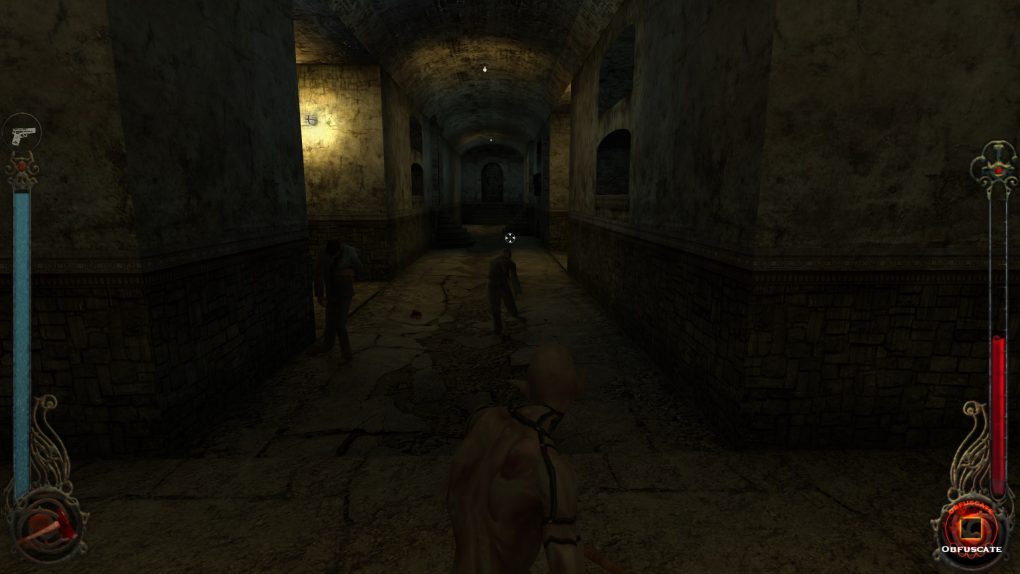
It’s well known that Bloodlines was badly rushed, which is why it’s unplayable without an unofficial patch. It’s also why the last quarter of the game moves too quickly without the Unofficial Patch – why Chinatown has too little content, and why there is a lot less variation and use of social skills in the last quarter of the game compared to the rest. It was rushed, and it shows. The writing and amount of content and quality of content (quest design) in the last quarter does not demonstrate the excellence shown by the rest of the game. It’s not terrible, but it doesn’t quite do the game justice. But again, with the Unofficial Patch and its restored cut content, this discrepancy is reduced, and the last act barely feels rushed anymore. Bugs still exist though.
Still, all things considered, Bloodlines has such an interesting world. The story is filled with horror elements, introducing things such as ghosts, zombies, werewolves, other supernatural horror creatures and phenomen, Gehenna, the story of Caine (the first vampire), tying its horror into history in classic World of Darkness fashion. It always knows when to introduce a new element to throw you off, like an expert mystery story should. Bloodlines might be the only great mystery story in gaming.
The mechanics behind… everything is explained well, like how vampires function biologically. A level of detail most fiction is unable to get into. The backstory behind it all is intriguing and richly explored, unlike most modern day RPGs. The world and dialogue contain so much style that all meshes perfectly together, which so many of today’s RPGs are lacking. Bloodlines has real characters, interesting ones, not just quest giving bots or copypasta companions. Bloodlines also has roots in history and philosophy, and elements of satire as well that all add flavor to this already rich game.
From an era of superior RPGs, Bloodlines still stands out as one of the very best. Thus, compared to the RPGs today there’s no comparison. Bloodlines has much better than average writing, far more role-playing, but unlike today’s RPGs it was actually trying not only to innovate but to elevate the genre. Fallout: New Vegas was really the last RPG that tried to do this, although Divinity: Original Sin raised the bar for physics and environmental interaction in cRPGs.
Otherwise, mainstream RPGs today are greatly reducing role-playing in favor of cinematic fully voiced acted design, dumbing down gameplay to resemble action games because today’s mainstream audience can’t handle real RPG gameplay, and they keep reusing stories and plots from past RPGs but watering them down in the process. Then we have indie RPGs and too many cater to the nostalgia of deluded fans and end up deliberately trying to resemble a 1990s game even though we’re decades past that. There is much to take from the best 1990s cRPGs, but not everything, and most of these indie RPGs lack in writing quality/depth/originality even in world design, and combat is only a poor imitation of some of the classics. These indie cRPGs tend to copy only the weak elements of cRPGs and not the strong ones, amusingly enough.
Whereas Vampire: The Masquerade – Bloodlines takes on a 3D, more immersive visual style (that has aged like fine wine) with fully voiced NPCs, without reducing role-playing or dumbing down gameplay, while having a unique world and story. We get almost none of this today. Best of luck trying to find an RPG that really tries to create a unique, fleshed out, rich world. The 3D RPGs of today all try to take after action games more than RPGs and the writing resembles the worst of Hollywood (see BioWare, Bethesda Game Studios, and modern day Obsidian), and even the 2.5D ones (as if 2.5D vs 3D should have any impact on role-playing) have far less role-playing than Bloodlines.
As good as all of its writing is, one of the more impressive features is how every single conversation is rewritten if you play as a Nosferatu or Malkavian, not to mention how other races have more unique dialogue than most other RPGs, and it has gender and race specific dialogue choices as well. This makes Bloodlines one of only four RPGs that rewrites the entire game depending on your character build: Fallout, Fallout 2, and Arcanum rewrite it all for low intelligence characters, and Bloodlines does it for Nosferatu and Malkavian. So Bloodlines, the game with fully voiced NPCs, does this more than any other RPG!
Because of the state of the gaming industry today, playing Vampire: The Masquerade – Bloodlines is a real treat, but on the other hand it is saddening because such innovative, unique, and complex RPGs are certainly a thing of the past now.
Gameplay
The second thing you’ll notice upon launching this game, (the first being its awesome menu music) is its alarming lack of configuration settings. Next to no graphics settings, not even V-Sync! The unofficial patches don’t address this.
Thankfully it is not FPS capped and has no issues running at high frame rates (as in further glitches aren’t introduced). Forcing V-Sync through NVIDIA drivers works flawlessly, and it should for AMD drivers as well.
Bloodlines uses an alpha version of Source engine so it will always be rather unpolished. With the unofficial patch, you can expect issues with AI (although they aren’t as severe as expected). The game is still stable with the unofficial patch and easily playable, but not polished. We’ll get more specific later in this review.
Character creation is excellent. Not much physical customization, as expected given the time period, but seven races to choose from plus gender choice for each. If Troika had time to finish the game, I wonder if we would’ve seen all thirteen vampire clans be playable?
Player race (clan) in this game makes tremendous impact on… every facet of the game. It makes more of a difference on writing and role-playing than every other game in existence, and affects gameplay as well. Modern RPGs are afraid to do all of this. A few games make race impact gameplay more (mostly authentic D&D games like the Neverwinter Nights series), but none make it affect plot and role-playing as much.
Two clans in particular, Nosferatu and Malkavian, affect the game more than the others. Nosferatus are hideous, monstrous creatures, such that the public cannot even see them or else they endanger all supernaturals. If you play as a Nosferatu and get too close to a person, you will violate the Masquerade unless you kill them before they alert anyone else. Every Masquerade violation removes a Masquerade point, and losing all five will end the game in failure. It is possible to redeem Masquerade points through your actions.
Malkavian players are also seen differently by virtually everyone in the game, and have unique dialogue all the time. The undertone for Malkavian is insanity, something inherent to their bloodline. The entire game was rewritten for both Nosferatu and Malkavian characters, and other clans have unique dialogue and encounters as well, and so do specific clan + gender combinations. So even the other clans/races besides Malkavian and Nosferatu bring more changes than every RPG I’ve played other than Arcanum.
The stats system is as good as one would hope from a video game based on a tabletop RPG. Logical, fundamental, robust, far better than almost all RPGs born in the video game medium. Experience points can be put into any of the stats represented by red or black circles in the above screenshot, including Humanity. It is a more flexible system than something like D&D. There’s some redundancy and overlap though, due to some attributes only affecting one skill. The attributes should be condensed.
There are plenty of viable options for combat, and some clans are better than others at certain ones. Nosferatus for example should always use stealth. Stealth is an option, guns are an option, melee weapons are an option. What isn’t an option is non-lethal, unfortunately. The only non-lethal attack is feeding on unsuspecting victims, but if they are already hostile then they are not incapacitated by this.
Combat balance is incomplete due to the rushed nature of the game. It is only capable of providing challenge in a few boss fights and maybe two other quests (helping Ash escape through the sewers and underneath the Society of Leopold church), but the abysmal AI is extremely exploitable and late game balance can be laughably in your favor. You become more overpowered in this game than most others, on par with only The Elder Scrolls III: Morrowind of all games I’ve played, but you can become this overpowered much sooner in Bloodlines since it’s not equipment dependent whatsoever here.
A bad character build can make things challenging though, and game journalists today would certainly find it to be challenging, perhaps even too much.
By 2004 standards, Bloodlines had somewhat fluid but still unremarkable combat. By today’s standards it is only slightly clunky and lacks some of the responsiveness from well designed skill-based action games, but the amount of variety helps. It features no iron sights for guns and a crosshair size that depends on your firearms skill like Deus Ex. Melee combat is simple: attack with LMB by default with your swing being determined by your stance/movement, blocking is present and the window for blocking is on the strict side meaning timing is important. Sneak attacks from behind on unsuspecting victims are possible and result in an instant kill if executed in time. No non-lethal takedowns.
I take issue with feeding being able to fail on unsuspecting victims. This shouldn’t happen. Success of feeding is based on your unarmed skill which alone is perfect, but I feel that this should only apply to combat scenarios.
Different melee weapons swing at different speeds depending on weight. There is a surprising amount of guns, it doesn’t have the most in the world but it has enough for anyone, for this type of game. Headshots are far more damaging but not instant kills even on mortals. Kindred are of course much more durable than mortals, as is part of the lore and this extends to you. Maximum health is somewhat dependent on race/clan, as are Disciplines which are supernatural powers. Different clans get different Disciplines. Bloodlines does not hold back with its role-playing.
Your health meter regenerates slowly on its own (stat dependent like everything else) but is sped up by feeding, which if you haven’t guessed refers to drinking the blood of mortals. You can also acquire blood packs, which are healing items in 3 flavors. There is a blood meter that is akin to “mana” or “magicka” and it is drained by the use of Disciplines. This blood meter is increased directly by feeding.
You can feed on humans or rats. Rats are far less nourishing but are nourishing enough for Nosferatus. Every race other than Nosferatu can pursue a “romance” option (not actually romance at all, just a personal blood doll) and other NPCs become blood dolls who let you feed on them willingly, useful for gameplay purposes.
The inventory is not good. It is not weight dependent which is fine, nor is it space dependent. Technically you can carry as much as you want (but not as much of one item as you want, like ammo or health items), but it is possible to pick up more items than the inventory is capable of displaying, in which case you will have to drop visible items to access hidden ones because there is no scrolling.
As far as difficulty modes, Bloodlines has none unfortunately.
The best part about combat is the Disciplines. They are fun to use. The gore (which can be disabled) makes regular violence rewarding. AI is awful since AI nodes weren’t even possible in this alpha version of Source. AI is incredibly easy to exploit, so combat is not the main attraction for Bloodlines. Stealth is very easy, which given the unfinished AI is a good thing I’ll say. AI at least doesn’t see through the back of their heads, and as usual crouch walking is silent. But the Disciplines are well designed and very fun! Some aid with combat, others stealth, others create dialogue options, so much variety.
That’s all we have to say about gameplay. Continue to the next page to learn more about its story, without spoilers.
How Modern Technology Would Improve It
This is a new feature I’m adding to reviews of old games, or backwards newer games using/mimicking old technology to target nostalgia over quality. PC gamers today are often extremely backwards minded and against innovation, hence modern game design typically reflecting this.
Although every favored classic game utilized technology to improve itself to the point of becoming a classic, this fact is lost on most PC gamers today. So it is necessary to analyze how a classic or modern technologically regressive game would benefit from the latest and greatest technology, since we have the technology today to overcome almost all game design limitations of the past.
There are some interesting ways in which modern technology could improve Bloodlines, or a Vampire: The Masquerade game in general. Here’s a list of some ideas:
- Making light/dark a proper gameplay element via path traced lighting. It’s already a stealth game, and Nosferatu have to stay out of sight which usually means in the shadows. It’s clunky and awkward with broken, nonsensical and static raster lighting. With path traced rendering, this would actually work properly as how concealed the player is would depend purely on illumination. It would also aid enemy detection via dynamic shadows, indirect lighting (RTGI), and reflections for non-vampires.
- Real time path traced audio would transform the sound scape, elevating it so that reverb and occlusion are physically accurate and can actually travel distances
- Fire is an important gameplay element, so dynamic fire propagation would seriously enhance this
- AI acceleration for NPCs could make them capable of speech and retain memory, which has so much potential for elevating RPGs
- With modern distance-based level streaming systems like Unreal Engine 5’s World Partition, as well as an extremely efficient geometry rendering pipeline using mesh shaders, all loading screens can be omitted and the game could be transformed into an open world instead of a segmented Los Angeles. Manual LODs would also be eliminated.
- The game would benefit with a destructible environment, as would most games. This benefit would be noticed mostly with the flamethrower and dynamic fire propagation, with the fire destroying things like in Teardown.
Audio & Visuals
| 64-bit | No |
|---|---|
| Linux Support | No |
| Graphics API | DirectX 9 |
| Frame Rate | Unlocked |
| High Resolution Support | Yes |
| Ultrawide Support | Yes |
| High Refresh Rate Support | Yes |
| Borderless Windowed Support | Requires third party software (SRWE or Special K recommended) |
| VR | No |
| Display HDR | No |
| Shader Compilation Stutter | No |
| Ray Tracing | No |
| Mesh Shader Virtual Geometry Pipeline | No |
| NVIDIA Micro-Meshes | No |
| Advanced Distance-Based Level Streaming System with No Loading Screens | No |
| Variable Rate Shading | No |
| Sampler Feedback Tiled Texture Streaming | No |
| Sampler Feedback Texture-Space Shading | No |
| DirectStorage/RTXIO | No |
| Multicore CPU Support | 1-2 cores cores |
| GPU Physics | No |
| Adjustable FOV | Config File Edit or Console Command |
| Anisotropic Filtering | Config File Edit or Forced via GPU Drivers |
| Anti-Aliasing and Upscaling | Externally Forced Only (SSAA recommended) |
| Sound API | DirectSound3D (DSOAL recommended) |
| Sound | Up to 7 channels (config file edit required) |
| Dolby Atmos | No |
| UI Scaling | No |
| “Analog” Keyboard Support | No |
| Debug Console | Yes |
| Modding | Yes |
Vampire: The Masquerade – Bloodlines was the first ever Source engine game, therefore it was one of the better looking games around although Half-Life 2 edged it when it released shortly after. Nonetheless, for its time every single aspect of its graphics were very impressive, water and character models most of all. Animations were lacking, and it still wasn’t top tier (behind not only Half-Life 2 but also DOOM 3 and Far Cry).
Being a Source engine game, physics are of course on display, although they are far glitcher than Half-Life 2 not to mention there are less physics objects. But, it’s better than overly static games which plagued gaming then and still does now.
The lack of graphics options, including anti-aliasing and V-Sync, is the only thing to complain about really, since it means the game was not scalable. Not a problem today since any modern PC can run it easily. V-Sync can be forced through GPU drivers, and so can ambient occlusion and MSAA, SSAA, and HSAA via NVIDIA drivers. All of this is shown in our screenshots.
I am happy to report no ill effects when running Bloodlines at over 60 FPS. I play the game at 120 FPS with V-Sync, HBAO+, and SGSSAA forced through NVIDIA drivers, and the game has no issues with this.
Being on Source engine, Bloodlines has facial animations that surpass lots of modern games like the dreadful Fallout 4. Every major character has very distinct facial animations and general animations in combat, successfully conveying their thoughts, feelings, or perhaps showing only a front for what they want you to believe. But it works very well even by modern standards, compared to modern games.
Sadly the general animation quality isn’t as good as its facial animations, due to the game being released before it was complete. Not enough time was allowed to create as much animations as say Half-Life 2.
Bloodlines has an amazing soundtrack. So fitting for the style and setting. Voice acting is very good even by today’s standards, being on the same level as games like Fallout: New Vegas. By 2004 standards it was top notch in this area.
Sound effects are incomplete in places; lots of debris make the same sound when collision, footsteps in sewers are out of sync with your movement. Aside from this, sound effects are acceptable but not of the highest quality. Gunshots at least sound pretty good.
An environmental audio option is available and it works, creating dynamic echoes/reverb but I have noticed no other special effects. However, it seems that it needs to be enabled for the game to output surround sound, otherwise it’s stereo only. I needed to use some cfg file tweaks to get 5.1 surround to work. The code can be found below, copy it into the autoexec.cfg files (create it if need be) in Vampire\cfg and Unofficial_Patch\cfg in your main Bloodlines folder.
snd_mixahead "0.35" snd_surround "1" snd_gain "2.2" snd_gain_max "1.58" dsp_on "1" dsp_spatial "73" dsp_dist_max "9999" hisound "1" footstep_pc_vol "0.31"
Note that surround localization/spatial accuracy is not any better than other Source games. I do not believe that this game uses DirectSound3D, but rather DirectSound with its own environmental audio implementation (not EAX). I don’t think the environmental audio is hardware based either, but I could be wrong.
Bloodlines has unusually high quality voice acting. Considering how unique every single character is (something only Planescape: Torment can boast about on equal footing), they are supported by such spot on voice acting to really capture the quality of the dialogue. You will not find more effective voice acting than this.
Now let’s move on to the conclusion on the next page.
Conclusion
Vampire: The Masquerade – Bloodlines is one of the finest RPGs ever made, and one of the most innovative of the 2000s. It is an action RPG without less role-playing than turn-based or real-time with pause RPGs… in fact it has more role-playing than almost every other video game. I have seen comments around the internet stating that action games cannot be good RPGs; while such comments are obviously baseless and illogical, this is one of the best games to use as an example to shut them up. Only Fallout 2 and Arcanum can arguably be said to offer role-playing than it.
Role-playing, world design, story, characters, and dialogue are the strongest aspects of Bloodlines. Personally, I was never into vampire stories at all, but Bloodlines has made me a fan of Vampire: The Masquerade. While playing Bloodlines, I could not get enough of the lore.
It is an official, licensed Vampire: The Masquerade product, thus existing canon besides the pen and paper RPG. One might expect that this mandates emphasis on lore and well written world building, and Bloodlines will not let such a person down. It even does justice to legendary Vampire: The Masquerade characters like Smiling Jack and Beckett. Bloodlines is a mix of topics, themes, genres even, such that the player never knows what to expect. It can seamlessly transition from a more classic but incredibly well done horror theme such as the Ocean House Hotel to delivering satirical social commentary riddled with intricate details, to being outright witty and hilarious, and much, much more. This is an impressive feat in its own right, not just for a video game. It takes supreme writing talent to pull this off, but Bloodlines makes it look easy.
Even for those initially uninterested in Gothic style vampire stories (such as I), Bloodlines will be captivating. Its writing is simply too good, too inviting, for it to be anything less.
Its biggest flaw is that it was rushed and released incomplete. An unofficial patch is required to play it, and even that doesn’t fix everything. But the remaining bugs are easy to overlook. Bloodlines is more ambitious than every RPG being made today and released within the last few years, and has an amount of role-playing that video games unfortunately no longer strive for.
Strengths
- Outstanding role-playing both from a narrative and gameplay perspective
- Excellent writing quality overall, character development and world building rivaled by very few games in existence
- Brilliant, incredibly immersive and relatable setting
- Fleshed out hub-based levels with tons of quest content
- Good, logical adaptation of core Vampire: The Masquerade rules for gameplay
- Includes many clans to play as, features intriguing selection of Disciplines too
- Awesome soundtrack
- Very nice art design that has aged exceptionally well. I was amazed at how nice it looks on a 4k OLED screen with forced ambient occlusion (ReShade MXAO) and forced HDR through Windows.
Weaknesses
- Requires Unofficial Patch to be playable
- Lacks polish even with unofficial patch; AI is terrible, laughable amount of repeated character models, it almost adds to the charm since this game is both excellent and meme-worthy
- Combat balance is incomplete and laughably broken. Usually provides no challenge for anyone above game journalist level.


